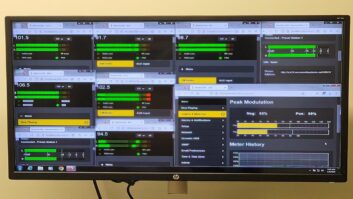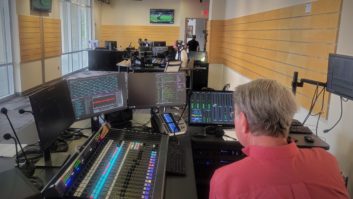What’s the difference between a network radio program today and one from 70 some years ago, during the time we now think of as the golden age of radio? You might say that it’s the style — today, it’s usually a “Morning Zoo” of music and talk, call-in shows, or a simple music service. Seventy years ago, it was block entertainment programs. Is that the big difference?
No. The big difference is the sound. Today it’s full fidelity and in stereo. This is the biggest change technically in network radio. Since the first network hookups in the early 1920s, the chains leased transcontinental telephone broadcast circuits. These circuits had changed very little in their first 60 years of use.
LO FI, HI NOISE
Fred Krock, retired chief engineer of KQED San Francisco, wrote a recollection in 2000 for the Bay Area Radio Museum called “That Radio Network Sound” (http://bayarearadio.org/schneider/netsnd.shtml). In it, Krock describes the 100 Hz to 5 kHz frequency response of the circuits connecting the radio stations of the country. There was 35 dB signal-to-noise ratio, “birdies,” whistles and other noise. He mentions that due to cost, the national circuits had actually been reduced in frequency response in the 1940s.
By the 1970s, much progress had been made in the art of broadcasting, but not in the networking of audio circuits. The number of circuits had continued to increase, but the equipment to condition the lines hadn’t changed much. Mark Durenberger, in his eBook on AT&T “Connecting a Continent” (www.durenberger.com), writes of the first NEMO (remote) equalizers designed to flatten the response of the low frequencies and then amplify the result. In 1970, this had not changed. The Radio Control Room at Michigan Bell in Detroit had 96 McIntosh tube amplifiers connected to a jack field populated with switches to “strap” various equalizer sections together, depending on the length of the line, for 5 kHz or 8 kHz circuits. Twenty dB of gain was available for bringing the level back up. Only a few equalizers were available for 15 kHz. These were used for the first and last “mile.” From the early days of broadcasting, these circuits were referred to as “Program” circuits, circuits of sufficient quality to be used for broadcast programs. This practice continued into audio circuits for television.
CHANGE IS IN THE (FM) AIR
Fig. 1: The NPR Landline distribution network, 1972.
Click To Enlarge
But things were changing. FM stations, broadcasting in full-fidelity stereo, were beginning to catch on with a younger generation wanting progressive rock. NPR was starting up a network of non-commercial, primarily FM stations. In 1972, the NPR landline (as seen in Fig. 1) looked similar to the long lines diagrams from 1945. This included an eastern round robin where stations could be switched in to feed the network. Few programs were sent on the line — “All Things Considered” at 5 p.m. ET and 8 p.m. ET (for the west coast). The program “Options” was sent weeknights at 6:30 and 9:30 ET. Weekday mornings, there was a 15-minute BBC news program picked up via shortwave and retransmitted on the line. “Jazz Revisited” with Hazen Schumacher was switched in to the NPR round robin from Ann Arbor on Saturday nights. (Mr. Schumacher passed away just last summer; see http://michiganradio.org, keyword Schumacher.)

Only one program could be sent on the line at a time. Special programs required the disruption of the regularly scheduled programs. ABC Radio, in an attempt to serve all formats, established four services on a single network, which took up most of the hour and required special handling for breaking news bulletins.
BETTER FIDELITY, BY TAPE
Many other programs were sent to stations on reel-to-reel tape and mailed out each week or “bicycled” from one station to the next depending on timeliness and the producer’s wishes. This was the only way to get high-quality music programs to stations from major orchestras. There were also such unique programs as “The Casper Citron Show” recorded at a round table in the Algonquin Hotel and Joseph Tushinsky’s “Keyboard Immortals Play Again” on the Welte piano vorsetzer.
Many religious programs were sent on tape to stations. The “Renfro Valley Gatherin’” played Sunday morning on many stations and was live on CBS Radio originally and mailed to stations as an LP record. On the non-commercial side, NPR maintained a tape duplication facility and many hundreds of tapes were sent out and returned each week — a very expensive operation.
CHANGE IS IN THE (SATELLITE) AIR
By the late 1970s, FM listening had increased, the number public radio stations on the FM band had increased dramatically and many listeners wanted the sound that FM radio provided. AT&T couldn’t provide this at a reasonable cost. NPR, PBS and the Corporation for Public Broadcasting had been discussing satellite delivery for several years, and in early 1979, construction started on the public radio satellite system, to be administered by a new NPR division devoted to satellite distribution.
Fig. 2: The original Public Radio satellite system. The red dots indicate an uplink.
Click To Enlarge
The first station to be connected was KWAX in Eugene, Ore., on August 30, 1979. NPR Executive Vice President Tom Warnock, speaking to the KWAX listeners over satellite on that day, talked about live full-fidelity stereo programs from 17 different transmit terminals around the country and that these programs would sound the same as coming from the studios of your local station. The satellite interconnected stations are shown in Fig. 2 with the origination terminals as red dots. Warnock also spoke of the programs that might evolve because of this new distribution.

New programs were indeed waiting. Regularly scheduled live program distribution started in October 1979 and the network was completed by May 1, 1980, on schedule. The first “new” program, as predicted by Tom Warnock, was a variety program called “A Prairie Home Companion,” and it started national distribution just two days after the scheduled NPR satellite system completion on Saturday, May 3, 1980. By the end of 1980, the NPR member stations added more sets of demodulators to keep up with the programming demand available to them by satellite.
Within a few years, transportable origination terminals (a fancy name for remote uplink trucks) were in operation by NPR and other satellite system operators. Use of satellite for backhaul of sports broadcast was common and provided higher quality for these popular broadcasts.
In the 35 years since 1980, all radio networks migrated to satellite distribution. The system at NPR has been upgraded not once but twice, first to a digital signal from the expanded 24 uplink terminals around the U.S. (still real-time transmission), and again with the advent of Internet protocol technology from a single uplink. The IP technology enabled file distribution of recorded programs and live programs all as Internet streams all within a closed satellite system. Satellite distribution of network programs was a major change that affected every station and every listener. Did we realize it at the time? I don’t think so. Did the listener realize it? No. The listener heard what they expected: full-fidelity stereo programming in real time. In my opinion, satellite distribution avoided what could have presented a monumental problem in the years following its commissioning: the breakup of AT&T and its Long Lines division.
CHANGE IS IN THE EARTH
What’s next? Ironically, the next-generation path could return back to Earth: wired (fiber optic) distribution to all stations. This could lead to two-way transmission from one station to the network or point-to-point to any other station. As Mark Durenberger quotes from Rodney E. Nilk, “Everything that was once wireless is now wired. Everything that is wired is now wireless.”
Some content for this article came from the 1979 folder “Public Radio by Satellite: For the Sake of the Sound,” which was distributed to all stations and used with permission from NPR, as was the Long Lines network map produced by NPR engineering.
John Holt retired last year after more than 40 years in the broadcast industry, most recently as chief engineer at American University’s popular WAMU(FM) in Washington. He is an avid student of broadcast history and vintage broadcast microphones. He served for 10 years on the board of the Washington-area Radio History Society, now known as the National Capital Radio & Television Museum.












